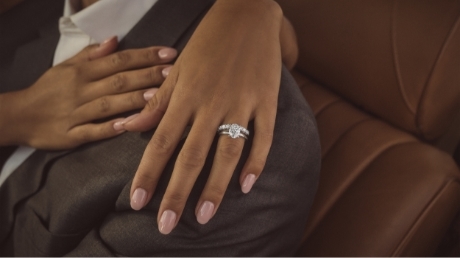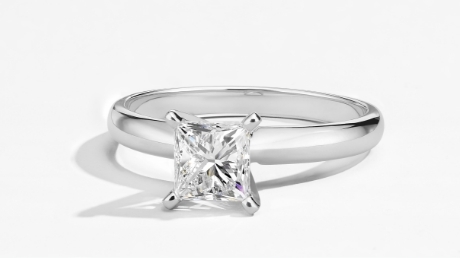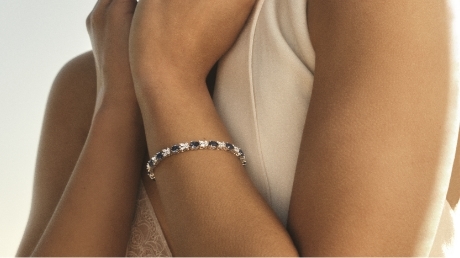A diamond is the world’s most enduring symbol of love. Whether you’re celebrating a milestone anniversary or making an everyday moment sparkle, there are now more ways than ever to find the diamond that tells your unique story. Today, lab-grown diamonds and diamond alternatives are growing in popularity as more affordable options to natural diamonds.
Learn more about how lab-grown diamonds compare to natural diamonds and explore some of the most popular diamond alternatives, so you can find the diamond option that’s right for you.
What Are Lab-Grown Diamonds: Core Differences Between Natural vs. Lab-Grown
Lab-grown diamonds (also referred to as engineered, man-made, or lab-created diamonds) possess the same optical, chemical, and physical properties as a natural diamond. Natural vs. lab-grown diamonds are virtually indistinguishable to the untrained eye. What sets them apart, however, are their origin and the time they took to form.
Natural diamonds are formed over billions of years deep below the earth’s surface, under extreme pressure and high temperature. They rise and become accessible by volcanic eruption.
SHOP NATURAL DIAMONDS
Lab-grown diamonds are produced in a lab within weeks or months, using specialized technology that mimics the extreme heat and pressure of a natural diamond’s growing environment.
SHOP LAB-GROWN DIAMONDS
Comparing Natural vs. Lab-Grown Diamonds
Find out how natural diamonds vs. lab-grown diamonds compare, so you can decide which option is right for you.
| KAY Diamond Comparison | Natural Diamonds | Lab-Grown Diamonds |
|---|---|---|
| Is it a Diamond? | Yes | Yes |
| Primary Chemical Composition | Carbon | Carbon |
| Source | The Earth | A Laboratory |
| Time to Create | 1 to 3 Billion Years | Several Weeks to Months |
| Supply/Rarity | Finite and Rare | Unknown at this Time |
| Independently Certified | Yes* | Yes* |
| 100% Conflict-Free | Yes | Yes |
| KAY Responsible Sourcing Commitment | Yes | Yes |
| Industry Sourcing Standards Established | Yes | In Development |
| Included in the Lifetime Diamond Commitment | Yes | Yes |
| Eligible for Trade-In | Yes | Yes |
| Price Comparison (of comparable quality and size) | $$$ | $$ |
| *Select styles & carat weights | ||
Shop KAY with Confidence
Whether natural or lab-created, all of our diamonds are 100% conflict-free. Each is transformed by our experts, who map, cut, and polish the diamond from its rough form to bring to life the precious stone’s unique sparkle, fire, and brilliance.
Exploring Diamond Alternatives
While diamond alternatives (also known as diamond simulants) are made to look like the real deal, they have very different chemical and physical properties. As their name implies, simulant diamonds merely imitate the appearance of a diamond, and generally do not possess the same level of brilliance or durability as natural or lab-created diamonds. However, diamond alternatives are an excellent budget-friendly option.
White Sapphire Vs. Diamonds
White sapphire is available in natural and lab-grown varieties. Natural white sapphires are typically more expensive than lab-grown stones, but they can look milkier and have visible inclusions. Lab-grown white sapphires are clearer and more affordable than their natural counterparts. White sapphires are very durable, but they are not nearly as brilliant, fiery, or sparkly as a diamond.
EXPLORE LAB-GROWN WHITE SAPPHIRES
Cubic Zirconia (CZ) Vs. Diamonds
Cubic zirconia is probably the most commonly known diamond alternative. CZ is often found in children’s and costume jewelry, but it is sometimes used in placeholder and lower quality engagement rings. It is an artificially produced version of the element zircon. Colorless CZ is common, but its brilliance is easily diminished when it gets dirty. It weighs almost twice as much as a diamond, and, like moissanite, has a lot of fire. It is often cut with larger facets to make the fire less noticeable, but those large facets can also make it look more artificial. CZ has good hardness, but it scratches more easily than a diamond.
EXPLORE CUBIC ZIRCONIA
Moissanite Vs. Diamonds
Moissanite is a silicon carbide crystal that’s made in a lab. It is extremely hard, but still more likely to scratch than a diamond. It has a lot of fire—a rainbow effect seen when light hits the stone—but moissanite lacks the brilliance and sparkle of a diamond. This rainbow effect can also make it look more artificial. Many moissanites are colorless, but it is more susceptible to color changes from heat. The color likely won’t hold up as well as a diamond over time. KAY does not offer moissanite products at this time.
Frequently Asked Questions
From how they’re made to quality and value, get answers to your most frequently asked questions about lab-grown diamonds here.
Diamond Education from the Experts
Lab-Grown Diamonds
Lab-created diamonds come in a variety of classic and modern shapes and cuts. Explore your options to find a diamond that fits your style.
The Four Cs of A Diamond
Understanding the cut, color, clarity and carat of a diamond can help you choose the one that suits your lifestyle and budget.
Lab-Grown Gemstones
Learn more about lab-grown jewelry and explore KAY’s stunning selection, so you can find the perfect gift!




 They will be on video but won't see you.
They will be on video but won't see you. Make sure to enable your mic if prompted.
Make sure to enable your mic if prompted. Language:
Language:





